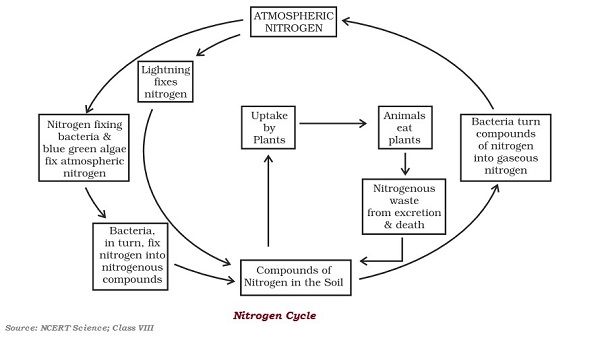
- Biology - Home
- Biology - Structure and Functions
- The Fundamental Unit of Life
- Biology - Tissues
- Biology - Animal Tissue
- Diversity in Living Organisms
- Biology - Plantae Kingdom
- Biology - Animalia Kingdom
- Biology - Vertebrata
- Biology - Transportation in Humans
- Biology - Transportation in Plants
- Biology - Excretion
- Biology - Control and Coordination
- Biology - Hormones in Animal
- How do Organisms Reproduce?
- Biology - Sexual Reproduction
- Biology - Reproduction in Animals
- Reaching the Age of Adolescence
- Biology - Heredity and Evolution
- Biology - Life Processes
- Biology - Respiration
- Microorganisms: Friend and Foe
- Biology - Why do We Fall Ill
- Biology - Natural Resources
- Biology - Our Environment
- Conservation of Plants and Animals
Biology - Microorganisms: Friend and Foe
Introduction
The living organisms (available around us), which we cannot see with our naked eyes, are known as microorganisms or microbes.
-
Microorganisms are classified into the following four major groups −
Bacteria
Fungi
Protozoa
Algae
Viruses
Viruses are also microscopic microorganism.
Viruses get reproduced only inside the cells of the host organism, which may be a bacterium, plant, or animal.
The common ailments, such as cold, influenza (flu), and coughs are caused by viruses.
The serious diseases, such as polio and chicken pox are also caused by viruses.
The diseases like dysentery and malaria are caused by protozoans.
The diseases like typhoid and tuberculosis (TB) are caused by bacteria.
The single celled microorganisms are known as bacteria, algae, and protozoa.
The multicellular microorganisms are known as fungi and algae.
The microorganism can survive in any type of environment ranging from ice cold to hot desert.
Microorganisms are also found in the bodies of animals and human beings.
Microorganisms, such as amoeba, can live alone; whereas the fungi and bacteria live in colonies.
Some of the microorganisms are beneficial to us in many ways whereas some others are harmful and cause diseases to us.
Friendly Microorganisms
Microorganisms are used for various purposes, such as preparation of curd, bread, cake; production of alcohol; cleaning up of the environment; preparation of medicines; etc.
In agriculture, microorganisms are used to increase soil fertility by nitrogen fixation.
The bacterium lactobacillus helps in the formation of curd.
The microorganisms, yeast is used for the commercial production of alcohol and wine.
For the large scale use of yeast, it is grown on natural sugars present in grains like wheat, barley, rice, crushed fruit juices, etc.
The process of conversion of sugar into alcohol (by yeast) is known as fermentation.
Streptomycin, tetracycline, and erythromycin are some of the commonly used antibiotics; these are made from fungi and bacteria.
These days, antibiotics are mixed with the feed of livestock and poultry that check microbial infection in the animals.
Several diseases, such as cholera, tuberculosis, smallpox and hepatitis can be prevented by vaccination.
In 1798, Edward Jenner discovered the vaccine for smallpox.
Harmful Microorganisms
The microorganisms that cause diseases to human beings, animals, and plants, are known as pathogens.
Pathogens enter into humans body through the air while breathing, the water while drinking, or the food while eating.
Some pathogens are transmitted by direct contact with an infected person or carried through an animal.
The microbial diseases that normally spread from an infected person to a healthy person through air, water, food or physical contact are known as communicable diseases. E.g. cholera, common cold, chicken pox, tuberculosis, etc.
Female Anopheles mosquito carries the parasite of malaria and known as carrier.
Female Aedes mosquito carries the parasite of dengue virus.
Human Diseases
The following table illustrates some Common Human Diseases caused by Microorganisms −
| Human Disease | Causative Microorganism | Mode of Transmission |
|---|---|---|
| Tuberculosis | Bacteria | Air |
| Measles | Virus | Air |
| Chicken Pox | Virus | Air/Contact |
| Polio | Virus | Air/Water |
| Cholera | Bacteria | Water/Food |
| Typhoid | Bacteria | Water |
| Hepatitis B | Virus | Water |
| Malaria | Protozoa | Mosquito |
Microorganisms causing Disease in Animals
In 1876, Robert Kch discovered the bacterium (Bacillus anthracis), which causes anthrax disease.
Anthrax, a dangerous disease caused by a bacterium, affects both human and cattle.
Foot and mouth disease of cattle is caused by a virus.
The following table illustrates some Common Plant Diseases caused by Microorganisms −
| Plant Disease | Causative Microorganism | Mode of Transmission |
|---|---|---|
| Citrus canker | Bacteria | Air |
| Rust of wheat | Fungi | Air, seeds |
| Yellow vein mosaic of bhindi (Okra) | Virus | Insects |
Food Preservation
Salts and edible oils are the common chemicals usually used to check the growth of microorganisms, they are known as preservatives.
Sodium benzoate and sodium metabisulphite are also used as common preservatives.
Common salt is usually used to preserve meat and fish for ages.
Sugar reduces the moisture content, which prevents the growth of bacteria; therefore, Jams, jellies, and squashes are preserved by sugar.
Use of oil and vinegar averts spoilage of pickles, as bacteria cannot live in such kind of environment.
When the milk is heated at about 700C for 15 to 30 seconds and then swiftly chilled and stored; the process prevents the growth of microbes. This process was conceptualized by Louis Pasteur; therefore, it is known as pasteurization.
Nitrogen Cycle
